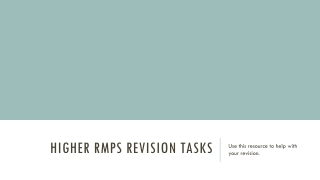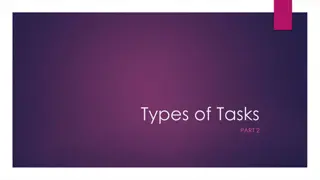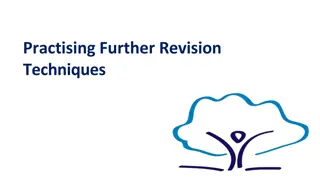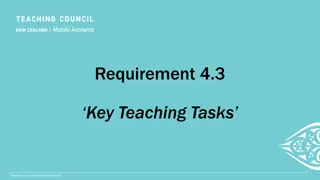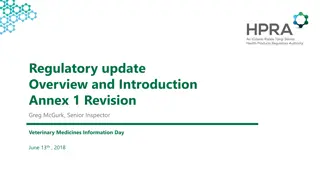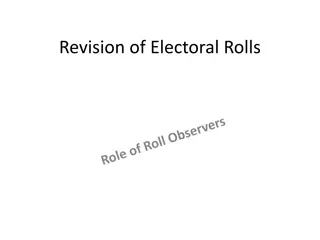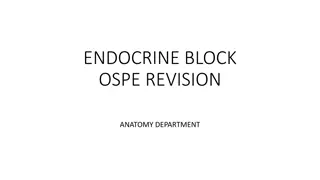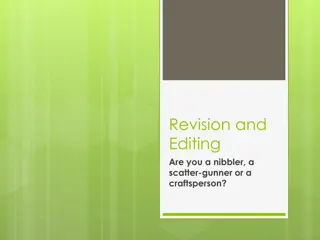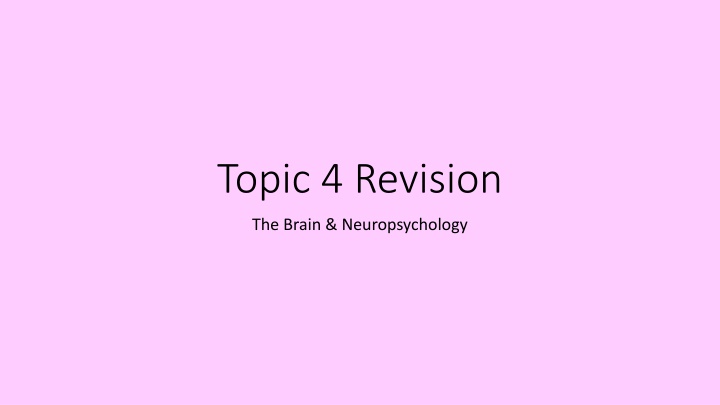
Understand Brain Lateralisation and Hemisphere Functions
Explore the structure, functions, and lateralisation of the brain hemispheres. Learn how each hemisphere controls different functions, the role of the corpus callosum in connecting them, and the impact of damage to specific hemispheres on language and other abilities.
Download Presentation

Please find below an Image/Link to download the presentation.
The content on the website is provided AS IS for your information and personal use only. It may not be sold, licensed, or shared on other websites without obtaining consent from the author. If you encounter any issues during the download, it is possible that the publisher has removed the file from their server.
You are allowed to download the files provided on this website for personal or commercial use, subject to the condition that they are used lawfully. All files are the property of their respective owners.
The content on the website is provided AS IS for your information and personal use only. It may not be sold, licensed, or shared on other websites without obtaining consent from the author.
E N D
Presentation Transcript
Topic 4 Revision The Brain & Neuropsychology
Know the structure and functions of the Brain Image result for label the brain
Know the structure and functions of the Brain PARIETAL LOBE Image result for label the brain FRONTAL LOBE OCCIPITAL LOBE TEMPORAL LOBE CEREBELLUM
Know the structure and functions of the Brain Responsible for hearing and understanding sounds, understanding speech and creating speech Image result for label the brain Helps us to process visual information from our eyes, and also helps to make sense of this information so we understand what we are seeing. Plays a vital role in movement, coordination and balance. Takes information from the different senses, spinal cord and other parts of the brain and combines them to coordinate behaviour. Plays an important role in decision-making and impulse control. Helps control problem-solving skills, concentrate and pay attention to different activities. Supports our ability to understand the world around us (perception). It gives us the ability to recognise faces.
Lateralisation of function in the hemisphere of the brain Lateralisation of function in the hemisphere of the brain Lateralisation of function means that...? The fact that the brain is asymmetrical refers to...? Each hemisphere of the brain seems to control the...? The two hemispheres are connected by the ...? This is a ...? It allows the two hemispheres of the brain to...? The left hemisphere plays a big role in language and this is associated with...? The right hemisphere plays a big role in...? If the left hemisphere is damaged a person might struggle to...? If the right hemisphere is damage a person might struggle to...?
Lateralisation of function in the hemisphere of the brain Lateralisation of function in the hemisphere of the brain Lateralisation of function means that...? Each hemisphere of the brain has different functions or jobs The fact that the brain is asymmetrical refers to...? The two hemispheres are not identical mirror images and do not perform the same functions Each hemisphere of the brain seems to control the...? Opposite side of the body The two hemispheres are connected by the ...? Corpus callosum This is a ...? Thick band of nerve fibres
Lateralisation of function in the hemisphere of the brain Lateralisation of function in the hemisphere of the brain It allows the two hemispheres of the brain to...? Communicate with one another to complete tasks The left hemisphere plays a big role in language and this is associated with...? Broca s area in particular The right hemisphere plays a big role in...? Spatial awareness, creativity, music and vision If the left hemisphere is damaged a person might struggle to...? Understand language or use language effectively and speak If the right hemisphere is damage a person might struggle to...? Recognise objects or people s faces
Sex Differences in Brain Lateralisation Sex Differences in Brain Lateralisation Sex differences in brain lateralisation Males and females brains work differently. Females were better at language skills (left-brain tasks) Harasty et al. (1997) suggested that parts of the brain that process and produce language are slightly bigger in females compared to males BUT Sommer et al. (2004) suggested that there was no strong evidence that females used both hemispheres for language tasks, Men were better at spatial skills (right-brain tasks) such as imagining what a shape would look like if it was shown from a different angle Rilea et al. (2005) found that males were better at some spatial tasks, especially those that use a lot of activity in the right hemisphere BUT this was not true in ALL cases. Females may have a thicker corpus callosum meaning they may use both sides of their brain for some tasks while males show dominance for one hemisphere for the same tasks with more activity in one hemisphere than the other
The role of the Central Nervous System GABA Plays a role in attention and learning. Not enough of this can make it difficult to concentrate on tasks. DOPAMINE Made up of the brain and spinal cord helps brain and body communicate SEROTONIN Chemicals found within the nervous system that pass messages from one neuron to another across a synapse. SYNAPTIC TRANSMISSION Plays a role in mood. Too little of this can make people feel depressed. NEUROTRANSMITTER The process by which neurotransmitters are released by a neuron, move across the synaptic gap and are then taken up by another neuron. CENTRAL NERVOUS SYSTEM A system of nerves connecting the CNS to skin, organs and muscles PERIPHERAL NERVOUS SYSTEM Plays a role in calming us down. When we feel stressed we produce this to relax us.
The role of the Central Nervous System VESCICLES SYNAPTIC GAP NEUROTRANSMITTERS RECEPTORS
The role of the Central Nervous System VESCICLES SYNAPTIC GAP NEUROTRANSMITTERS RECEPTORS NEUROTRANSMITTERS (the little black dot inside!) SYNAPTIC GAP VESCICLES (small sacs that contain the neurotransmitters) RECEPTORS (sites on neurons designed to absorb the neurotransmitter molecules)
Neurological damage Neurological damage Neurological damage refers to any damage of the ......................................... If the brain is damaged in some way, this can prevent .................................. being passed. It can also be that damage is on a small scale, with specific .................... being affected. Two kinds of neurological damage are .......................................... and ............................................ Agnosia is a problem in the way ......................... information is processed. A disorder in which a person can see an object perfectly well, but is unable to understand what they are seeing is called ................................................... When a person has prosopagnosia this is also sometimes called ............................................... and it is a problem in the area of the brain called the .......................................................................... It means that a person cannot recognise a persons face, even if they know them well. MESSAGES NEURONS NERVOUS SYSTEM SENSORY FUSUIFORM FACE AREA FACE BLINDNESS VISUAL AGNOSIA PROSOPAGNOSIA VISUAL AGNOSIA
Neurological damage Neurological damage Neurological damage refers to any damage of the NERVOUS SYSTEM If the brain is damaged in some way, this can prevent MESSAGES being passed. It can also be that damage is on a small scale, with specific NEURONS being affected. Two kinds of neurological damage are VISUAL AGNOSIA and PROSOPAGNOSIA Agnosia is a problem in the way SENSORY information is processed. A disorder in which a person can see an object perfectly well, but is unable to understand what they are seeing is called VISUAL AGNOSIA. When a person has prosopagnosia this is also sometimes called FACE BLINDNESS and it is a problem in the area of the brain called the FUSIFORM FACE AREA It means that a person cannot recognise a persons face, even if they know them well.
Damage to the Pre-frontal Cortex If this part of the brain becomes damage, a person can become impulsive and aggressive. The murderers had less activity in this area of the brain which could explain them being more impulsive and less regulated emotionally Damage to the pre-frontal context can also affect their emotional control and so this can lead to personality changes, just like people reported happened to Phineas Gage. Put the statements about damage to the pre-frontal cortex in the correct order to explain the impact of this kind of damage. Raine et al (1997) found clear differences in the pre-frontal cortex of murderer s compared with criminals who had not committed murder The pre-frontal cortex is where impulse control, decision-making and emotional regulation happen. This type of damage can also increase criminal behaviour.
Damage to the Pre-frontal Cortex The pre-frontal cortex is where impulse control, decision-making and emotional regulation happen. If this part of the brain becomes damaged, a person can become impulsive and aggressive. Put the statements about damage to the pre-frontal cortex in the correct order to explain the impact of this kind of damage. This type of damage can also increase criminal behaviour. Raine et al (1997) found clear differences in the pre-frontal cortex of murderer s compared with criminals who had not committed murder The murderers had less activity in this area of the brain which could explain them being more impulsive and less regulated emotionally Damage to the pre-frontal context can also affect their emotional control and so this can lead to personality changes, just like people reported happened to Phineas Gage.
KEY STUDIES FOR TOPIC FOUR KEY STUDIES FOR TOPIC FOUR The study can be criticised as all data was based on reports which were over 150 years old, meaning it may not have been valid and it was a case study meaning that it is not generalisable. A criticism of this study is that external validity in may be low because the stimuli was selectively delivered to one hemisphere which doesn t happen in real life. Researchers located the skill and iron in a USA museum and took x-rays, precise measurements and deformed a 3D brain model to match All damage was in the frontal lobes in the ventromedial region. Broca s Area was undamaged. They generated five possible trajectories which could be responsible for the injuries and agreed on one which was most likely. A piece of apparatus that allowed testing of the right and left halves of the visual field separately or together (and the right and left hands and legs with the vision excluded) was used and 6 tasks completed. One strength of this study is that all the participants completed the same tasks in the same way which means the procedures were standardised. This makes the study easier to replicate increasing its reliability. To identify the location of damage in Phineas Gage using modern neuroimaging techniques. The findings showed that the right hemisphere was able to read words, which allowed patients to recognise objects and make mental associations, process emotional reactions and solve simple maths as well as being better at spatial awareness. To find out the cognitive functions that are linked to each hemisphere in the brain. The findings from the tasks showed that the left was the primary hemisphere for processing language based information, but some was also processed in the right to an extent. They studied other patients with damage to the same area and 12 of them had trouble making rational decisions and processing emotions. 11 patients who had undergone surgery to split their corpus callosum following severe epilepsy. This is a small sample and so cannot be generalised as it is not representative.
KEY STUDIES FOR TOPIC FOUR KEY STUDIES FOR TOPIC FOUR The study can be criticised as all data was based on reports which were over 150 years old, meaning it may not have been valid and it was a case study meaning that it is not generalisable. A criticism of this study is that external validity in may be low because the stimuli was selectively delivered to one hemisphere which doesn t happen in real life. Researchers located the skill and iron in a USA museum and took x-rays, precise measurements and deformed a 3D brain model to match All damage was in the frontal lobes in the ventromedial region. Broca s Area was undamaged. They generated five possible trajectories which could be responsible for the injuries and agreed on one which was most likely. A piece of apparatus that allowed testing of the right and left halves of the visual field separately or together (and the right and left hands and legs with the vision excluded) was used and 6 tasks completed. One strength of this study is that all the participants completed the same tasks in the same way which means the procedures were standardised. This makes the study easier to replicate increasing its reliability. To identify the location of damage in Phineas Gage using modern neuroimaging techniques. The findings showed that the right hemisphere was able to read words, which allowed patients to recognise objects and make mental associations, process emotional reactions and solve simple maths as well as being better at spatial awareness. To find out the cognitive functions that are linked to each hemisphere in the brain. The findings from the tasks showed that the left was the primary hemisphere for processing language based information, but some was also processed in the right to an extent. They studied other patients with damage to the same area and 12 of them had trouble making rational decisions and processing emotions. 11 patients who had undergone surgery to split their corpus callosum following severe epilepsy. This is a small sample and so cannot be generalised as it is not representative.

